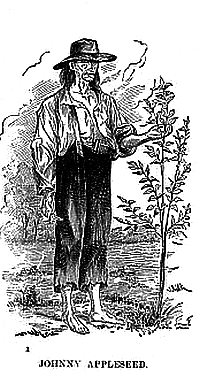Johnny Appleseed
John "Johnny Appleseed" Chapman (September 26, 1774 - March 18, 1845) is an American folk hero who was was a Christian missionary and pioneer. His nickname came from the fact that he planted apple trees throughout the American Midwest. Many people consider him an early conservationist, or "tree-hugger." He wandered the country, usually barefoot, and with a cooking pot on his head for most of his adult life. He plantied apple trees; taught the Bible; told stories; and befriended Native Americans, wild animals, and other settlers.
Many stories have been told about him and his journeys, as well as art, books, and later movies, which makes him a folk hero. He was born in Leominster, Massachusetts, and is buried in Johnny Appleseed Park, in Fort Wayne, Indiana.
Facts
John Chapman is said to have been in the Wilkes-Barre region some time in the 1790s, practicing his profession as a nurseryman. However, just when he embraced the Swedenborgian faith and began his missionary activities is unsure, but it was probably before he ever reached western Pennsylvania.
There are some early accounts of John speaking of his own activities as "a Bible missionary" on the Potomac when he was a young man, and Johnny was seen for two or three consecutive years along the banks of the Potomac in eastern Virginia while he was picking the seeds from the pomace of the cider mills in the late 1790s. The apple seeds that Johnny obtained were free, as the cider mills wanted more apple trees to be planted to improve their business.
At the time of his death, Johnny left an estate of more than 1,200 acres of nurseries, and he left them to his sister. He additionally had four plots located in Allen County, Indiana, which was a nursery that included 15,000 trees.
Records show that John Chapman appeared on Licking Creek, in what is now Licking County, Ohio, in 1800, when he was 26 years old. He had probably come up the Muskingum River to plant near the Refugee Tract, which would soon fill up with settlers, when Congress actually got around to granting the lands. The Continental Congress had ratified resolutions to donate public lands for the benefit of those who had left Canada and Nova Scotia to fight against the British during the Revolutionary War. The lands were actually set apart in 1801, and patents were issued in 1802.
Grants of land ranging from 160 acres to 2,240 acres were awarded according to the exertions of the patentee in the war. Johnny, with true Yankee enterprise, went ahead and planted his nurseries before the refugees arrived. Licking County, then part of Fairfield County, contained only three white families. When families were ready to settle in the area, Johnny's tracts of land were already ready for market.
Johnny Appleseed Media
Other websites
- http://johnnyappleseedfacts.com/ Archived 2011-02-08 at the Wayback Machine



